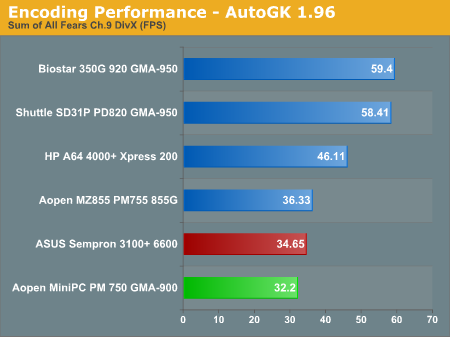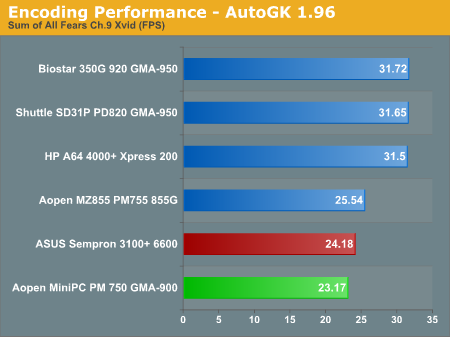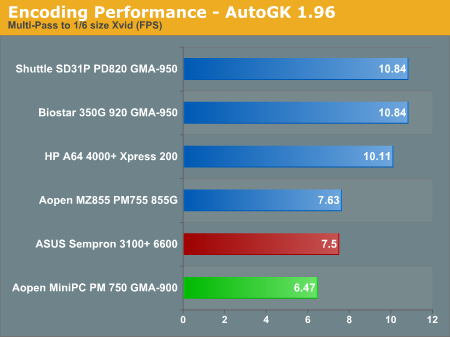Updated: AOpen MiniPC – Imitation is the Sincerest Form of Flattery
by Jarred Walton on March 3, 2006 12:05 AM EST- Posted in
- Systems
Encoding and Multimedia Benchmarks
Using AutoGK, we tested the multimedia encoding capabilities of the systems. For HTPC use, we tested the playback of several different video files as well and checked CPU use. For video playback, we used DVI as well as component output running 720p resolutions. We also tested performance connected to a Dell 2405FPW running at the native 1920x1200 resolution of the display, as video scaling can increase the load on the system for video content. The Pentium 4 506 chip had some issues during testing, so unfortunately, we didn't get AutoGK results with it.
DivX and Xvid encoding are good enough for casual use, but clearly, the Pentium M chip is not as fast as other platforms. Even the lowly Sempron 3100+ outpaces the Pentium M 740, though the margin is relatively close. Running a Core Duo processor would help quite a bit, but even that wouldn't catch up with Pentium D or Athlon X2 performance. For multimedia creation, the MiniPC is probably too slow for serious work. However, if you just want to encode the occasional video clip, letting the system process the file overnight will get the job done before you wake up in the morning. WMV9HD encoding is a different matter, but that's slow even on the fastest dual core systems.
Video Decoding
If you have a second PC doing the encoding work, the MiniPC works quite well as an HTPC. For video playback, there won't be any graphs, but I instead focused on the overall experience. Lower demand playback like MPEG-2 isn't even remotely a problem, so let's move on to the more demanding tasks.
Playing back 720p and 1080i content - even with scaling the video to fill the screen - worked without a hitch, with the CPU running a maximum of 50-80% load. (We'll talk a bit more about 1080i content later.) Every now and then, you might see a slight skip, most likely caused by another application using the hard disk, but otherwise, HDTV content worked fine. DivX and Xvid playback presented no difficulties either, with CPU load for both under 25% at typical (720x480) resolutions. DivXHD used more CPU time for the higher resolution, but playback still only used about 50% of the CPU power.
The other systems were all equal to the MiniPC or substantially better, but the bottom line is that for the currently most common video formats, all of the tested systems handled MPEG-2/HD/DivX/Xvid video playback with enough CPU power left in reserve that stutters shouldn't be a problem. Multitasking might present problems on the slower systems, of course, so we wouldn't recommend trying dual display output on the MiniPC with one display showing an HDTV stream, if you're trying to get work done, but few people really do that in our experience.
WMV9HD is a different story, but we've come to expect that from our most brutal video playback tests. 720p was okay, though it sometimes struggled (hitting upwards of 80% CPU usage); basically, it ran about as well as a 1080i HD transport stream. 1080p on the other hand was essentially unwatchable. Dual cores and even GPU acceleration are pretty much required to get completely smooth WMV9HD support for 1080p content; even a fast Athlon X2 or Pentium D will struggle with 1080p WMV9HD decoding, unless the GPU offloads some of the work. As nice as WMV9HD looks, it's difficult to justify the performance requirements at this time. DivXHD files encode and decode with much less CPU power, and file sizes are pretty comparable. As long as you stick to the other less CPU intensive codecs, the MiniPC will work fine.
Using AutoGK, we tested the multimedia encoding capabilities of the systems. For HTPC use, we tested the playback of several different video files as well and checked CPU use. For video playback, we used DVI as well as component output running 720p resolutions. We also tested performance connected to a Dell 2405FPW running at the native 1920x1200 resolution of the display, as video scaling can increase the load on the system for video content. The Pentium 4 506 chip had some issues during testing, so unfortunately, we didn't get AutoGK results with it.




DivX and Xvid encoding are good enough for casual use, but clearly, the Pentium M chip is not as fast as other platforms. Even the lowly Sempron 3100+ outpaces the Pentium M 740, though the margin is relatively close. Running a Core Duo processor would help quite a bit, but even that wouldn't catch up with Pentium D or Athlon X2 performance. For multimedia creation, the MiniPC is probably too slow for serious work. However, if you just want to encode the occasional video clip, letting the system process the file overnight will get the job done before you wake up in the morning. WMV9HD encoding is a different matter, but that's slow even on the fastest dual core systems.
Video Decoding
If you have a second PC doing the encoding work, the MiniPC works quite well as an HTPC. For video playback, there won't be any graphs, but I instead focused on the overall experience. Lower demand playback like MPEG-2 isn't even remotely a problem, so let's move on to the more demanding tasks.
Playing back 720p and 1080i content - even with scaling the video to fill the screen - worked without a hitch, with the CPU running a maximum of 50-80% load. (We'll talk a bit more about 1080i content later.) Every now and then, you might see a slight skip, most likely caused by another application using the hard disk, but otherwise, HDTV content worked fine. DivX and Xvid playback presented no difficulties either, with CPU load for both under 25% at typical (720x480) resolutions. DivXHD used more CPU time for the higher resolution, but playback still only used about 50% of the CPU power.
The other systems were all equal to the MiniPC or substantially better, but the bottom line is that for the currently most common video formats, all of the tested systems handled MPEG-2/HD/DivX/Xvid video playback with enough CPU power left in reserve that stutters shouldn't be a problem. Multitasking might present problems on the slower systems, of course, so we wouldn't recommend trying dual display output on the MiniPC with one display showing an HDTV stream, if you're trying to get work done, but few people really do that in our experience.
WMV9HD is a different story, but we've come to expect that from our most brutal video playback tests. 720p was okay, though it sometimes struggled (hitting upwards of 80% CPU usage); basically, it ran about as well as a 1080i HD transport stream. 1080p on the other hand was essentially unwatchable. Dual cores and even GPU acceleration are pretty much required to get completely smooth WMV9HD support for 1080p content; even a fast Athlon X2 or Pentium D will struggle with 1080p WMV9HD decoding, unless the GPU offloads some of the work. As nice as WMV9HD looks, it's difficult to justify the performance requirements at this time. DivXHD files encode and decode with much less CPU power, and file sizes are pretty comparable. As long as you stick to the other less CPU intensive codecs, the MiniPC will work fine.










54 Comments
View All Comments
Questar - Friday, March 3, 2006 - link
Where else in the x86 market is Apple not price competetive?rowcroft - Friday, March 3, 2006 - link
Considering it's Friday, the new Mac Mini's were announced on Tuesday (one is on a FedEx truck on it's way to my house) the article really shouldn't have the errors that it does. You can certainly tell Anand didn't write this one....JarredWalton - Friday, March 3, 2006 - link
There are a couple places where I mention the fact that this has already been superceded by the new Mac Mini. Considering this product is less than two months old (and really only 1 month in the US), the choice is either to not review it at all or to review it and basically end up with "nice, but unless you're a die-hard Windows user the Mac Mini is better." If it wasn't clear that I think that the Mac Mini is the better choice, I apologize. However, for people dead set on XP, until the MP945 is launched you really don't have any other option that uses a Pentium M chip. The only factual error right now (that is corrected) is that a USB X-Fi doesn't exist, unless you've spotted something else?rowcroft - Saturday, March 4, 2006 - link
I was referring to comments about i386 macs not yet shipping on the first page and overall sense that there the comparable mini's are the one's released a year ago now. I was a bit too harsh though, I apologize for that.JarredWalton - Saturday, March 4, 2006 - link
Oh... heh. That intro page was written a couple weeks ago, then the article got delayed as I waited for some answers and other information. I'll change it to the present tense instead of future tense. Of course, we're still waiting for a "Windows on Intel Macs" solution. I'm betting Vista will be necessary, as I don't know if it's even feasible to get XP runnign on an EFI architecture without massive effort. (First person to prove me wrong gets a pretty sizeable check, I suppose.)Nocturnal - Friday, March 3, 2006 - link
I have worked with many laptops and this unit doesn't look that much different from the pictures although the pictures are probably a little bigger than the actual unit (I think?). Other than that, I'd definately invest in one of these for the wife.themelon - Friday, March 3, 2006 - link
There are quite a few USB audio devices on the market today, including an X-Fi product from Creative.They have a USB X-Fi? It's not on there product page and this is the first time that I have seen mention of one.
JarredWalton - Friday, March 3, 2006 - link
Right you are. I could have sworn I saw a Creative X-Fi USB, but I'm clearly mistaken. The best Creative USB option is still the Audigy 2 NX (right?). I will fix this error.psychobriggsy - Friday, March 3, 2006 - link
Pointless unless you have a Windows based application that you need to use.And for the uses this type of system will be good for, there aren't many of those.
If you want a small system, then the Mac Mini is clearly the better choice, and will be cheaper to boot. AOpen really need to trim their prices when they release their more-equivalent update.
There is still the issue of the market size for a computer this small. In home entertainment systems you have the option of creating a system as large as your standard HiFi separate. Elsewhere the large box can be stuck under the desk. However it is ideal as a zero-configuration computer, one that you'll use until it dies or you replace it.
It feels really odd writing 'Macs are cheaper and better' ...
Hikari - Friday, March 3, 2006 - link
Page two says, "Open has cloned the original Mac Mini with a system that is going to be faster in nearly every area."How old is this review? This isn't even close to as fast as a Mac mini with a Core Duo in it and 945G chipset. You just might want ot make sure you're making it clear that its slower than the old G4-based mini.